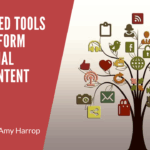 Creating content for your website or social media pages – or to sell – is a lot of work. Nobody who creates content for a living would suggest otherwise. And if you’re not careful, it can end up costing you far more to produce than you can afford to spend.
Creating content for your website or social media pages – or to sell – is a lot of work. Nobody who creates content for a living would suggest otherwise. And if you’re not careful, it can end up costing you far more to produce than you can afford to spend.
The solution is to build an efficient system that allows you to fast-track your process and minimize the time it takes you to create the quality content you need.
Of course, the trick is that you need to build the system before you can use it. That might seem to be a daunting task, but it’s not difficult if you have some guidance. Here are 8 steps to build a system that works for you.
#1: Set Your Content Goals
Before you build your system, you must identify the goals you hope to achieve with your content. Goals are essential because they’ll inform the topics of your content as well as the form it takes and where you share it.
Your goals might involve anything from growing your subscriber list to increasing your sales. I can’t tell you what they are, but you must define them before you can move to the next step. Remember that your goals must be SMART: smart, measurable, achievable, realistic, and time-bound.
#2: Create a Customer Persona
Once you have your goals, the next step is to create a customer persona that represents the ideal customer or lead for your products. The customer persona you create should include:
- Demographic information (age, gender, marital status, etc.)
- Psychographic information (interests, likes, and dislikes)
- Pain points (what problem or dilemma do they need a solution for)
- Objections (what might keep them from buying your product)
The more specific you are, the easier it will be to create content that will be useful to your target audience.
#3: Choose the Types of Content You Want to Create
Different formats of content require different tools, which is why I suggest identifying the types of content you want to create to meet your goals at this stage. Of course, you will need to be flexible, because you may find that you need to experiment with new formats if the ones you brainstorm at this stage don’t get the results you want.
Some format types to consider include:
- Blog posts
- Infographics
- Instructables
- Videos
- Checklists
- Memes
The formats you select should be informed by both your goals and your customer persona. If you know your ideal customer is someone in their teens or 20s, for example, then memes might be extremely effective. For older people, videos and blog posts might be a better option.
#4: Make a Content Creation Schedule
A content creation schedule tells you when you want to post specific content, so you can plan your time accordingly and assemble the resources and talent you need to adhere to your schedule.
Your schedule should include:
- The content you want to create
- The place where you will post it (your blog, Facebook, Instagram, etc.)
- The date and time you will post it
You may also want to get specific about scheduling your time and the time of your team members. For example, if you know that you need to give your writer a week of lead time to create a blog post and that you’ll need a couple of days after it’s delivered to optimize it and create images to go with it, then you should plan on assigning the post to your writer at least 10 days before its scheduled posting date.
#5: Assemble Your Content Creation Toolbox
One of the best things about the time we live in is that we all have access to an array of free and paid tools we can use to streamline content creation. Your content creation system will be at its most efficient if you have a set of reliable tools you can use.
I always include lists of tools with my products. Here are a few of my favorites:
- Canva is a tool with free and paid options, ideal for creating social media posts and presentations. With the paid version, you can access thousands of templates.
- Microsoft Sway is a tool you can use to create slides and presentations.
- Otter Voice Notes is useful for creating transcripts of video and audio content.
- Anchor is a tool you can use to transform audio and video content into podcasts.
- Venngage is a tool you can use to create beautiful and unique infographics.
Veed Audio Transcription has a list of easy to use audio transcription tools worth checking out too.
This is just a small sampling of the tools that are available. It may make sense to invest in paid versions of tools that will help you create the types of content you share the most.
#6: Create Templates
When it comes to creating content quickly, templates are the single most important tool to have on hand. When you create a template, you do the work once and reap the benefits many times. For example, you might decide to create a branded template for your memes or infographics and then use it multiple times.
The biggest benefit of creating templates for your content is that you can virtually eliminate repetitive work. Instead of walking through the steps of setting up a meme or video, you can bypass most of the preliminary work by using a template.
#7: Assemble Your Content Creation Team
Your content creation system will be most efficient when you have a stellar team to work within it. That means learning how to delegate tasks, hire freelancers, and outsource when it makes sense to do so.
Keep in mind that, in many cases, paying someone to create content will be less expensive than doing it yourself when you factor in your time and energy.
#8: Track Your Content and Fine Tune Your System
Even experienced content marketers don’t get everything right the first time. For that reason, it’s a must to keep an open mind and revise your system and schedule as needed.
For example, imagine that you decided on a content creation schedule that prioritized memes and instructables, but your results show that how-to videos are performing better than either of those two formats. You may need to revamp your schedule to allow for more video production, shifting time and resources accordingly.
Your content creation system should be a perpetual work in progress. You won’t need to rebuild it from the ground up, but it’s normal and expected to make small changes as you track your results.
Conclusion
Content creation can be time-consuming but building a reliable and efficient content creation system will help you stick to your schedule and make the best possible use of your time.




Thank you for your article. You can also use AutoSub for auto subtitle generation. It is very effective for video creation. It also provides free multi-language translation.